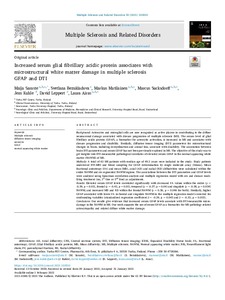Increased serum glial fibrillary acidic protein associates with microstructural white matter damage in multiple sclerosis: GFAP and DTI
Kuhle Jens; Bezukladova Svetlana; Airas Laura; Matilainen Markus; Sucksdorff Marcus; Saraste Maija; Leppert David
https://urn.fi/URN:NBN:fi-fe2021042826770
Tiivistelmä
Background
Astrocytes and microglial cells are now recognized as active players in contributing to the diffuse neuroaxonal damage associated with disease progression of multiple sclerosis (MS). The serum level of glial fibrillary acidic protein (GFAP), a biomarker for astrocytic activation, is increased in MS and associates with disease progression and disability. Similarly, diffusion tensor imaging (DTI) parameters for microstructural changes in brain, including demyelination and axonal loss, associate with disability. The association between brain DTI parameters and serum GFAP has not been previously explored in MS. The objective of the study was to get insights into DTI-measurable pathological correlates of elevated serum GFAP in the normal appearing white matter (NAWM) of MS.
Methods
A total of 62 MS patients with median age of 49.2 years were included in the study. Study patients underwent DTI-MRI and blood sampling for GFAP determination by single molecule array (Simoa). Mean fractional anisotropy (FA) and mean (MD), axial (AD) and radial (RD) diffusivities were calculated within the entire NAWM and six segmented NAWM regions. The associations between the DTI parameters and GFAP levels were analysed using Spearman correlation analysis and multiple regression model with sex and disease modifying treatment (no, 1st line or 2nd line) as adjustments.
Results
Elevated serum GFAP levels correlated significantly with decreased FA values within the entire (ρ = -0.39, p = 0.03), frontal (ρ = -0.42, p = 0.02), temporal (ρ = -0.37; p = 0.04) and cingulate (ρ = -0.38, p = 0.034) NAWM, and increased MD and RD within the frontal NAWM (ρ = 0.36, p = 0.046 for both). Similarly, higher GFAP associated with lower FA in frontal and cingulate NAWM in the multiple regression model corrected for confounding variables (standardised regression coefficient β = -0.29, p = 0.045 and β = -0.33, p = 0.025).
Conclusions
Our results give evidence that increased serum GFAP levels associate with DTI-measurable micro-damage in the NAWM in MS. Our work supports the use of serum GFAP as a biomarker for MS pathology-related astrocytopathy and related diffuse white matter damage.
Kokoelmat
- Rinnakkaistallenteet [19207]
